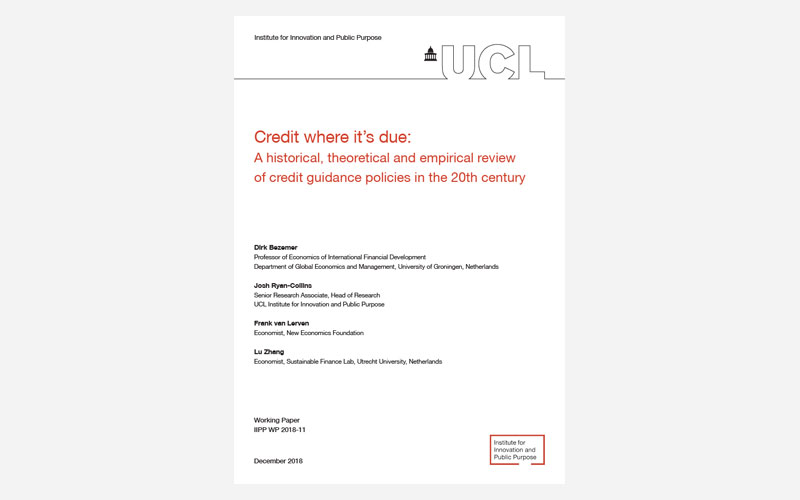Credit where it's due
A historical, theoretical and empirical review of credit guidance policies in the 20th century.

30 November 2018
UCL Institute for Innovation and Public Purpose (IIPP) Working Paper Series: IIPP WP 2018-11
Authors
- Dirk Bezemer | Professor of Economics of International Financial Development, Department of Global Economics and Management, University of Groningen, Netherlands
- Josh Ryan-Collins | Head of Finance and Macroeconomics, Senior Research Fellow, UCL Institute for Innovation and Public Purpose
- Frank van Lerven | Economist, New Economics Foundation
- Lu Zhang | Economist, Sustainable Finance Lab, Utrecht University, Netherlands
Reference
Bezemer, D., Ryan-Collins, J., van Lerven, F. and Zhang, L. (2018). Credit where it’s due: A historical, theoretical and empirical review of credit guidance policies in the 20th century. UCL Institute for Innovation and Public Purpose Working Paper Series (IIPP WP 2018-11). https://www.ucl.ac.uk/bartlett/public-purpose/wp2018-11
Abstract
Since the 1990s there has been a significant decline in the share of total bank credit flowing to nonfinancial firms relative to real estate and financial assets. This has raised concerns relating to economic growth and financial stability, and led to renewed interest in credit policy instruments and institutions. We examine the theoretical case for credit guidance policies; review the actual use of a range of credit policy instruments in the 20th century, including state investment banks; and also consider how critiques of such policies contributed to their demise in most advanced economies from the 1980s onwards. We then examine the empirical relationship between credit policy and credit allocation by the banking system over two time periods with different samples. For the 1973 to 2005 period, for advanced economies, we find that the liberalisation of credit markets and removal of credit guidance is significantly associated with a lower share of lending to non-financial firms. In contrast, for the 2000 to 2013 period, with a wider sample, including emerging markets, we do not find a significant relationship between the introduction of macroprudential policies and the share of lending to non-financial firms. We hypothesise this may be related to post-2000 interventions being primarily focused on financial stability concerns rather than credit guidance to support productive sectors of the economy. Both types of credit policy may be needed for sustainable economic growth and to ensure sufficient finance for major economic challenges, such as the transition to a low-carbon economy.
 Close
Close

